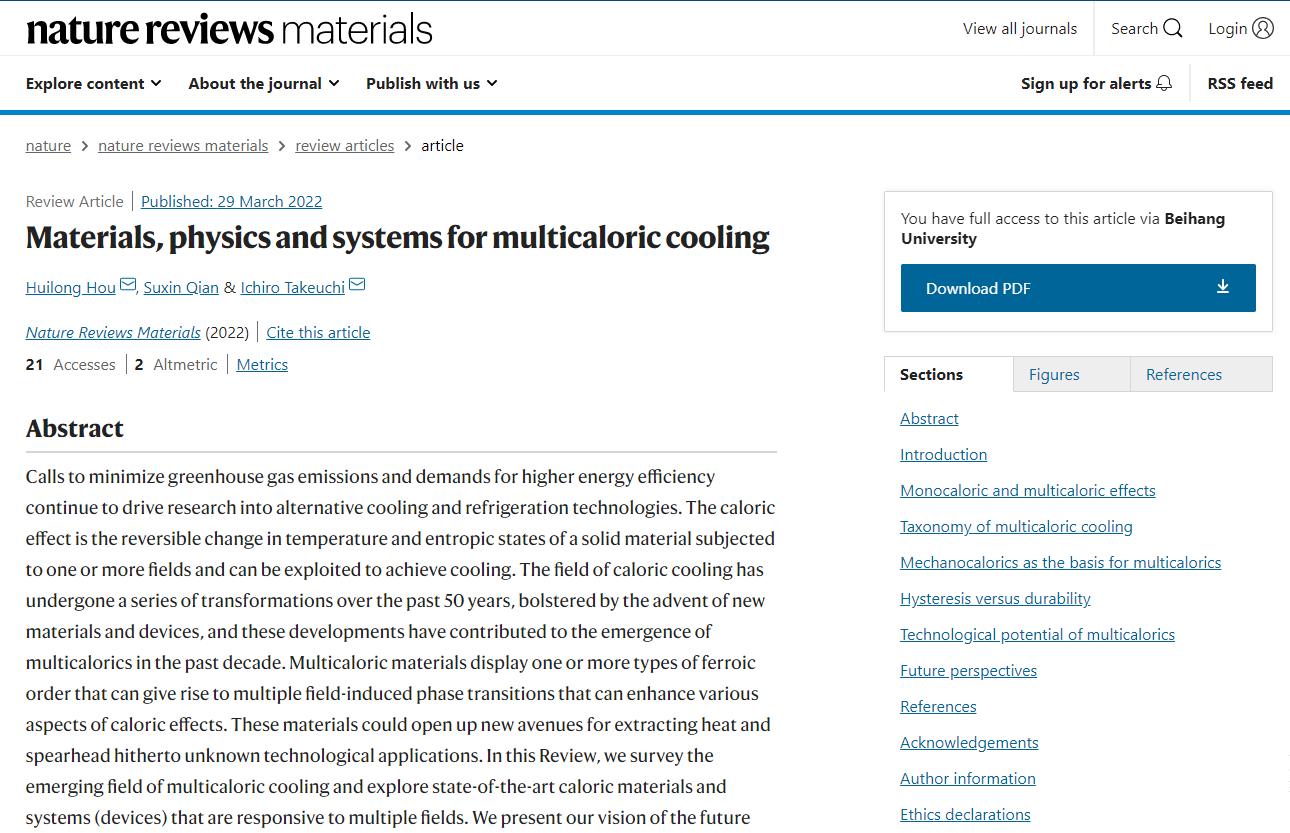On March 29, 2022, Nature Review Materials published a review article titled “Materials, physics and systems for multicaloric cooling”, a new progress made by Associate Professor Hou Huilong from the School of Aeronautic Science and Engineering of Beihang University in the field of solid-state cooling.

Cooling technologies based on caloric materials, which are solid materials that undergo reversible phase transformations and exhibit field-induced temperature, derive heat-pumping capabilities from the manipulation of internal order parameters. Caloric materials exhibit high energy-conversion efficiencies and do not emit greenhouse gases, which can not only boast huge economic and environmental value, but also appear to be promising for application in aeronautics and astronautics and space exploration.
In this review, original research work has been conducted at three levels: materials, physics, and systems, which successfully achieved effects of combination for field-induced entropy change, established a criterion for lengthening the functional lifetime of phase-transforming materials and optimized related evaluation system.
Nature Reviews Materials has a impact factor of 66.308, ranking first among all journals in materials science. This is the second article published in this journal by Beihang researchers (the first was published in 2017 by Professor Jiang Lei, academician of the Chinese Academy of Sciences).
Solid-state cooling technologies include single field-induced caloric effects such as elastocaloric effect, magnetocaloric effect and electrocaloric effect. In recent years, the parallel development of these monocaloric effects has converged to the focus point of multicaloric effects, and an emerging trend lies in multicaloric cooling, whereby multiple fields (magnetic, electric or stress) are applied to a multicaloric material to pump heat from low temperature to high temperature.
Associate professor Hou Huilong and his collaborators combed through and summarized single field-induced caloric effects such as elastocaloric, magnetocaloric, electrocaloric and barocaloric effects, as well as the development and status quo of multiple fields research. Their original research work was also conducted on this basis.

Fig. 1(a) Caloric cooling processes can be classified into four major categories depending on whether a material is single phase or composite and whether a single or multiple fields are applied for heat pumping. Analyze the relation between single field-induced caloric effect and multiple field-induced caloric effect in view of the magnetocaloric, electrocaloric and mechanocaloric effects of (b) single-phase materials and (c) composite materials. (d) Configurations of single-phase materials under a single applied field (I.1–I.3), single-phase materials under multiple fields (II.1–II.4), composite materials under a single field (III.1–III.3) and composite materials under multiple fields (IV.1–IV.4)
The energy dissipated as hysteresis in a back-and-forth transformation process is not the only mechanism that influences the functional fatigue life in phase-transforming materials. For elastocaloric alloys, it was proposed that the stored elastic energy that accumulates in the forward transformation provides the driving force for the reverse transformation, eliminating the need to lower the critical reverse transformation stress. In caloric cooling systems, the losses comprise four components: losses in the drive mechanisms that generate stimuli fields, heat-transfer losses between the caloric material and a transfer medium, losses during cyclic operations, and parasitic power dissipation (Fig. 2).

Fig. 2 Loss factors in monocaloric and multicaloric cooling systems
Associate professor Hou Huilong is the first author and corresponding author. The first affiliation is Beihang University. Collaborators are Associate Professor Qian Suxin from Xi’an Jiaotong University and Prof. Ichiro Takeuchi from University of Maryland. This work was supported by the National Natural Science Foundation of China, the Youth Talent Support Program of Beihang University, etc.

Hou Huilong
About the author:
Hou Huilong is an associate professor in the School of Aeronautic Science and Engineering, Beihang University. He received his PhD degree from the Pennsylvania State University in 2015 and worked as a postdoctoral researcher in University of Maryland from 2016 to 2019. Hou won the title of “Top 10 Young Science & Tech Figures in China" in 2000, and his representative research results have been published in many international top journals such as Science, Nature Communications, etc.
Link to the article:
https://www.nature.com/articles/s41578-022-00428-x
Reported by Qiao Liang
Reviewed by Bao Rui
Edited by Jia Aiping
Translated by Wen Li

